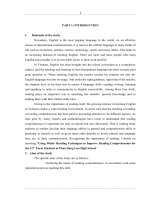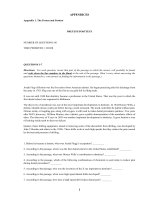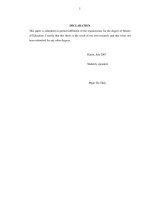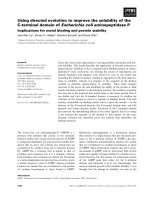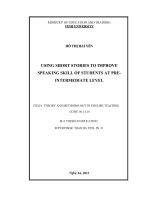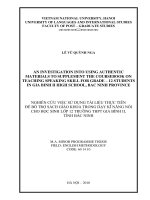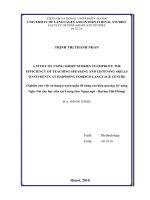Using authentic materials to improve reading comprehension of english majored students an experimental research project at a college in nam dinh
Bạn đang xem bản rút gọn của tài liệu. Xem và tải ngay bản đầy đủ của tài liệu tại đây (816.45 KB, 85 trang )
VIETNAM NATIONAL UNIVERSITY, HANOI
UNIVERSITY OF LANGUAGES AND INTERNATIONAL STUDIES
FACULTY OF POST - GRADUATE STUDIES
*********************
PHẠM THỊ HỒNG HIẾU
USING AUTHENTIC MATERIALS TO IMPROVE READING
COMPREHENSION OF ENGLISH MAJORED STUDENTS:
AN EXPERIMENTAL RESEARCH PROJECT AT A COLLEGE IN
NAM DINH.
(Sử dụng tài liệu nguyên bản để phát triển khả năng đọc hiểu cho sinh
viên chuyên ngành Tiếng Anh: nghiên cứu thực nghiệm tại một trường
cao đẳng ở Nam Định)
M.A. MINOR PROGRAMME THESIS
Field
: English Teaching Methodology
Code
: 8140231.01
HA NOI - 2020
VIETNAM NATIONAL UNIVERSITY, HANOI
UNIVERSITY OF LANGUAGES AND INTERNATIONAL STUDIES
FACULTY OF POST - GRADUATE STUDIES
*********************
PHẠM THỊ HỒNG HIẾU
USING AUTHENTIC MATERIALS TO IMPROVE READING
COMPREHENSION OF ENGLISH MAJORED STUDENTS:
AN EXPERIMENTAL RESEARCH PROJECT AT A COLLEGE IN
NAM DINH.
(Sử dụng tài liệu nguyên bản để phát triển khả năng đọc hiểu cho sinh
viên chuyên ngành Tiếng Anh: nghiên cứu thực nghiệm tại một trường
cao đẳng ở Nam Định)
M.A. MINOR PROGRAMME THESIS
Field
: English Teaching Methodology
Code
: 8140231.01
Supervisor : Nguyễn Thị Minh Trâm, PhD.
HA NOI - 2020
DECLARATION
I, the undersigned, declare that this thesis is the result of my own research and
has not been submitted to any other university of institution partially or wholly.
Except where the reference is indicated, no other person‟s work has been used
without due acknowledgement in text of the thesis.
Hanoi, 2020
Student
Phạm Thị Hồng Hiếu
i
ACKNOWLEDGEMENTS
This thesis could not have been completed without the help and support from a
number of people.
First and foremost, I would like to send my sincere thanks to my supervisor,
Nguyễn Thị Minh Trâm, Ph.D for her enthusiastic guidance, insightful comments,
and valuable support through my research.
I also would like to thank all of the lecturers of the Department of Post
Graduate Studies, Vietnam National University for their useful lectures and
materials which are of great value to my thesis.
Next, I want to show my appreciation for the responsible participation of thirty
English majored students at Nam Dinh College of Education where I conducted this
study. In addition, a special word of thanks goes to all of my colleagues at Faculty
of Foreign Languages, Nam Dinh College of Education. Without their contribution
and support, I would not be able to complete this research.
Last but not least, I owe my gratitude to my family for their support and
encouragement.
ii
ABSTRACT
Based on teaching experience at Nam Dinh College of Education (NCE), the
researcher has found that English majored students in our college seem to be bored
with the reading texts in the course book and unmotivated to learn, and even lack
vocabulary and background knowledge of real life. Therefore, the present
experimental research recruiting 30 second year English majored students at NCE
was conducted to explore the effectiveness using authentic materials to improve the
students‟ reading comprehension. They were then assigned to be an experimental
group and a control group (15 students per each). During the treatment of 8 weeks,
the experimental group was exposed to authentic materials. Pretest and posttest
were conducted in a pair sample T-test as means to distinguish the difference of
reading comprehension between the two groups. Next, follow-up semi-structured
interviews were carried out with 15 students from experimental group to investigate
their satisfaction level toward the lesson as well as their difficulties in reading the
authentic materials. The study results emphasized the research hypothesis that
authentic materials make significant improvement students‟ reading comprehension.
Consequently, the findings in this study result in some pedagogical implications for
teachers and students to improve students‟ reading comprehension. The research
might be useful for English language teachers, students as well as researchers.
iii
TABLE OF CONTENTS
DECLARATION ....................................................................................................... i
ACKNOWLEDGEMENTS ..................................................................................... ii
ABSTRACT ............................................................................................................. iii
LIST OF TABLES ................................................................................................. vii
LIST OF GRAPHS AND FIGURES .................................................................... vii
CHAPTER 1: INTRODUCTION ............................................................................1
1. Rationale for the study ............................................................................................1
2. Aim of the study and research hypothesis ..............................................................2
3. Scope of the study ...................................................................................................3
4. Method of the study ................................................................................................3
5. Significance of the study .........................................................................................4
6. Design of the study..................................................................................................4
CHAPTER 2: LITERATURE REVIEW ................................................................6
2.1. Overview of reading comprehension ...................................................................6
2.1.1. Definitions of reading .......................................................................................6
2.1.2. Definitions of reading comprehension ..............................................................7
2.1.3. Reading comprehension strategies/skills ..........................................................8
2.2. Authentic materials ............................................................................................10
2.2.1. Definitions of authentic materials ...................................................................10
2.2.2. Types of authentic materials ...........................................................................11
2.2.3. Benefits of authentic materials ........................................................................13
2.2.4. Drawbacks of authentic materials ...................................................................14
2.2.5. Criteria for selecting authentic materials ........................................................14
2.2.6. Stages of reading .............................................................................................15
2.3. Review of the previous related studies ..............................................................16
2.4. Summary ............................................................................................................18
iv
CHAPTER 3: METHODOLOGY .........................................................................20
3.1. The setting of the study ......................................................................................20
3.2. Research design ..................................................................................................20
3.3. Restatement of the research hypothesis .............................................................20
3.4. Participants and sampling ..................................................................................21
3.5. Data collection instruments. ...............................................................................21
3.5.1. Reading tests ...................................................................................................21
3.5.2. Interviews ........................................................................................................23
3.6. Data collection procedures .................................................................................23
3.6.1. The reading tests .............................................................................................23
3.6.2. Interviews ........................................................................................................25
3.7. Data analysis procedures ....................................................................................25
3.8. Summary ............................................................................................................25
CHAPTER 4: FINDINGS AND DISCUSSION ...................................................27
4.1. Tests ...................................................................................................................27
4.1.1. Results from pretest.........................................................................................27
4.1.2. Results from posttest .......................................................................................29
4.1.3. Comparison of the results between the control and experimental group ........31
4.1.4. Summary .........................................................................................................33
4.2. Interview ............................................................................................................34
4.2.1. Benefits of using authentic materials ..............................................................34
4.2.2. Difficulties and suggestions when using authentic materials .........................38
4.3. Summary ............................................................................................................40
CHAPTER 5: CONCLUSION ...............................................................................42
5.1. Summary of major findings ...............................................................................42
5.2. Implications of the research ...............................................................................43
5.3. Limitations of the study .....................................................................................45
5.4. Suggestions for further studies ...........................................................................45
REFERENCES ........................................................................................................47
v
APPENDICES ........................................................................................................... I
APPENDIX 1: Reading materials .............................................................................. I
APPENDIX 2: Suggested activities for using authentic materials .......................... VI
APPENDIX 3: Pretest ............................................................................................ VIII
APPENDIX 4: Posttest ........................................................................................... XV
APPENDIX 5: Interview questions .................................................................... XXIII
APPENDIX 6: The results of the control group‟s tests ......................................XXIV
APPENDIX 7: The results of the experimental group‟s test ............................... XXV
vi
LIST OF TABLES
Table 4.1. Descriptive statistics for pretest‟s results .................................................27
Table 4.2. Descriptive Statistics of posttest‟s results ................................................29
Table 4.3. Paired Sample T-test for pretest and posttest results ...............................33
LIST OF GRAPHS AND FIGURES
Graph 4.1. Pretest scores .............................………2Error! Bookmark not defined.
Graph 4.2. Posttest scores ......................................... Error! Bookmark not defined.
Graph 4.3. Pretest and Posttest scores ....................... Error! Bookmark not defined.
Figure 4.1. Students‟ difficulties when reading authentic materials .........................38
vii
CHAPTER 1: INTRODUCTION
1. Rationale for the study
Nowadays, globalization has become an essential part in the development of
every country. Together with this is the change in the status of English. It is obvious
that English is the most widely-used language all over the world since it appears in
all fields of life. Therefore, it is not surprising that English is considered
international or global language, in which reading comprehension is one of the most
important factors in English language learning for all students because it is the basis
of instruction in all aspects of language learning (Mikulecky, 2008). Particularly,
the ability to read efficiently is critical for successful academic pursuit among
students (Alvermann, 2002; Bernhardt, 2011; Grabe, 2010). As asserted by Guthrie
(2004), reading is the window to all knowledge. In other words, reading is the most
important skill to master out of the four skills in a second language (Alvermann &
Earle, 2003; Bernhardt, 2011).
Reading is one of the most important aspects of most English language
teaching programs, but it can also be one of the toughest for teachers and students.
Preparing for, understanding and assessing reading can all be a challenge.
Nevertheless, it has been found in previous studies that the application of authentic
materials in reading process is considered one of the most effective ways to widen
students‟ reading ability and their knowledge of real life. Nuttall (1996) commented
that authentic-based materials can be motivating because they are proof that the
language is used for real-life purpose by real people. The difference is not in the
language materials themselves but rather on their outcomes and their effectiveness.
Learners feel that they are learning a target language as it is used outside the
classroom. Authentic materials contain topics of interest to students and encourage
reading for pleasure, and they are practical and real because they provide valid
linguistic data (Martinez, 2002; Peacock, 1997). Berardo (2006) stated that
“authentic materials enable learners to interact with the real language and content
1
rather than the form”. In other words, authentic materials are undoubtedly an
efficient tool in reading lessons because they capture the interest and they stimulate
the imagination of students so that they will be more motivated to learn.
Vietnamese learners, in English classrooms, tend to be bored at reading
lessons. With five years of teaching experience at Nam Dinh College of Education
(NCE), the researcher has found that both teachers and the English majored students
are facing some problematic troubles in her context. Firstly, they are not provided
with various sources such as extra books, newspapers, magazines, and CDs by the
library. Yet, they are inactive to take any initiative to locate foreign language
resources or to seek for solutions to the problem. As a result, the language input,
students receive is mostly from the course books in the classroom so they find it
difficult to express their opinion due to the lack of vocabulary and background
knowledge of real life. Moreover, during classroom lessons, they seem to be bored
with the reading texts in the course book and unmotivated in learning. Many course
books have been used for such a long time that the content in these books seem to
be out-of-date or even not accurate in the current society. Realizing the issues, the
researcher thinks that it is crucial to provide alternative sources of reading other
than course book to help the students acquire better reading comprehension by
using a variety of authentic texts relating to the course topics.
From the facts mentioned above, the researcher thinks that it may be necessary
for English teachers to integrate authentic materials in the teaching reading process
at class. Therefore, with the approval from Faculty and participants, the author is
motivated to conduct an experimental research to investigate the effectiveness of
authentic materials applied directly at class on the development of students‟ reading
comprehension.
2. Aim of the study and research hypothesis
The study aims at investigating the effectiveness of the authentic materials on
developing second-year English majored students‟ reading comprehension.
2
Therefore, the hypothesis is: Students who are supplied with authentic materials
make better results at reading comprehension than other students.
Based on the above aim, the research involves two main objectives. First, it
investigates the differences in the performances between the control group and the
experimental group by the comparison of pretest and posttest‟s results. Therefore,
the research brings about an objective result about the effectiveness of authentic
materials. Second, with in-depth interviews, the researcher not only explores
students‟ attitudes towards authentic materials but also understands their
motivations as well as their difficulties when using authentic materials.
3. Scope of the study
The current experimental research is carried out to investigate only the
effectiveness of authentic materials on English majored students‟ reading
comprehension. Other reading skills are out of the scope of the study. Second, the
sources of authentic materials used in this research are mainly selected from
trustworthy online websites of appropriate difficulty and topics. Third, the reading
course focuses on developing pre-intermediate level for students who are 2nd year
English majored students at the third semester. Consequently, the materials of other
level of difficulty are outside the scope of inquiry.
4. Method of the study
Experimental research with two groups: control and experimental group was
conducted. The data collection instruments included pre-test, post-test, and in-depth
semi-structured interviews. The pre-test and post-test had the same structures which
are comprised of five tasks. Each task was a typical form of a reading test and to
check different reading comprehension skills. The results of pre-test and post-test
were compared between two groups in a pair sample T-test to check students‟
improvement after the treatment. Additionally, semi-structured interviews including
five questions were carried out with the participation of all students in the
experimental group. The purpose of the interviews was to explore the benefits of
using authentic materials, the difficulties of students when reading authentic
materials and ask for suggestions for future use.
3
5. Significance of the study
The findings of this study may provide the teachers and learners with a
useful case of authentic material application in improving students‟ reading
comprehension. Hopefully, the outcomes of this research might be a useful
reference for teachers to understand more about the benefits of authentic materials.
Theoretically, the research can emphasize the importance of authentic materials in
developing students‟ reading comprehension because they bring learners updated
content, interesting writing styles, various cultural values, knowledge, better reading
comprehension, and cooperative skills with others. Practically, the research
hopefully makes some suggestions about choosing and applying authentic materials.
It is important to select materials that are suitable for the average of students‟
ability. Besides that, teachers can give instructions and recommendations to help
students understand the texts better. Furthermore, the emphasis of teaching should
be laid on verbal interactions among students, on the initiation of real-life like
communication situations, on the use of techniques, as well as the use of authentic
materials. Importantly, this study is expected to serve as a reliable and helpful
source for other researchers who share the same interest in the topic and to throw
new light on integrating new language teaching methods.
6. Design of the study
This study consists of five chapters:
Chapter 1 is the introduction. In this part, the researcher gives an overview of
the research in which the author presents the rationale of the study, the aim of the
study, research hypothesis, methods of study, scope of the study as well as the
significance of the study and design of the study.
Chapter 2 is the literature review which provides an overview of the
theoretical background of learning reading comprehension, authentic materials in
second language acquisition, and the related previous studies.
Chapter 3, the methodology deals with the methodological frame work for the
study. It restates the research hypothesis and describes the setting, the participants,
and the research methods of the study.
4
Chapter 4 is the findings and discussion. The findings from the tests and
interviews will also be showed, discussed, and the recommendations are proposed.
Chapter 5 is the conclusion. In this part, the researcher will provide the
summary of the findings, contribution of this research and its limitations together
with some suggestions for further studies.
5
CHAPTER 2: LITERATURE REVIEW
2.1. Overview of reading comprehension
2.1.1. Definitions of reading
Identifying reading is often connected with the process of reading itself. It is
the cooperation which is normally silent, internal and private between the reader
and the text (Alderson, 2000, p.3), which means that reading is comprised of
multiple components involved. Specifically, the writer, the text, and the reader are
three essential ones during those processes since it is about how people make sense
of the written text so as to accomplish knowledge and understand author‟s
messages.
In addition, Goodman (1971) provides a more detailed definition, in which
reading is “a psychological process by which the reader, the language user,
reconstructs, as best as he can, a message which has been encoded by a writer as a
graphic display”, and the act of reconstruction is viewed as “a cyclical process of
sampling, predicting, testing and confirming.” Both William (1984) and Nutall
(1996) claim that reading is the “understanding what has been written”, and it is the
“act of reconstruction.”
Similarly, Anderson (1985) also shared that reading is a process of
constructing meaning from written texts. It is a complex skill which requires the
coordination of a number of interrelated sources of information. This means that
readers are required to mobilize both their background knowledge and practical
experiences to apply during the process of reading to acquire the best
comprehension.
Furthermore, reading, which is considered as the most important academic
skill in the educational process (Roundy and Roundy, 2009), is a complex structure
involving many diverse processes including seeing, perceiving, vocalizing and
interpretation. In other words, reading asks students to integrate numerous skills to
make out the text thoroughly, not simply only reading word by word by eyes.
6
Regarding the aim of reading, Spratt, Pulverness and William (2005) indicate
that the aim of reading is to make sense of the texts, which consists of
understanding letter, word and sentence level, also activating the background
knowledge (p.21). The readers need to base on their predictions, intelligence and
experiences to see the text‟s overall purposes and interpret the writers‟ intention
(Nuttall, 2000, p.16). Therefore, when readers deal with a text, they should
understand what the letters are, how the letters combine to build a word, and what
the meaning of the word combination is, then they can understand the sentence. In
fact, they can call their past experience or background knowledge to help them
interpret the meaning of the text. Here, rather than the text is at the heart of reading
process, the readers become an active participant in which their background
knowledge plays an important role in reading process.
To summarize, reading is not simply a receptive process of gathering
information by word per word, but an active process with the participation of the
writer, reader and the text as well.
2.1.2. Definitions of reading comprehension
Reading comprehension is undoubtedly the process of making meaning from
the given texts. The aim is to acquire an overall understanding of what is said or
implied in the text rather than to get the meaning of the isolated words or sentences.
Various definitions of reading comprehension have been available over the
years. The overriding aim of reading is to get the correct message from a text; the
message the writer intended for the reader to receive (Nuttall, 2000, p.4). The idea
of reading has been changed and moved from what was considered a receptive
process, as Harmer (2001) says that it is how people identify meaning from the text,
to what is now said as an interactive process. This condition can cause
misunderstanding by the reader, except the reader can comprehend the text well
because both the reader and writer depend on one another (Nuttall, 2000, p.11).
According to Klinger, Vaughn and Broadman (2007), reading comprehension
is a process of interaction between readers and what they bring to the text, such as
their prior or background knowledge and strategy use (p.8). This process also
7
includes the variables related to the text, for example the readers „interest of the
texts and their understanding of the genres of the texts. It means that what the
readers learn and how they respond and comprehend the text is individualistic. The
process of constructing meaning depends on the individual competencies, such as
experience and how to interpret the text.
As said before that reading comprehension is considered as a complex process,
Irwin (1991) cited in Klingner, Vaughn and Broadman (2007) proposed five basic
comprehension processes which work together simultaneously and complement one
another (pp. 9-11). They are micro processes (the ability to remember detailed idea
of a text that carries meaning), integrative processes (understanding and inferring
the relationships among clauses to make connection across sentences), macro
processes (the ability to set up ideas in a coherent way), elaborative processes
(connecting information provided in the text to the prior or background knowledge),
and metacognitive processes (the conscious awareness or control of cognitive
process).
To sum up, reading comprehension starts from the small unit of text which is
words, then phrases, clauses, sentences until texts. The comprehension depends on
the ability of the reader to draw meaning from the printed words to interpreting the
information appropriately. It may include the variable of text, such as vocabulary,
syntax, and grammatical and the variable of the reader namely the background
knowledge, cognitive development, strategy use, interest and purpose.
2.1.3. Reading comprehension strategies/skills
Reading in teaching and learning process is categorized as receptive skill
which is defined by Harmer (2001) as “the way in which people extract meaning
from the discourse” (p.199). Therefore, the readers do not need to produce any
language while reading, they play a role as the receivers, the ones who receive the
message of the text and get to understand it. In a reading lesson, the language is
used to derive messages from texts, or in reading lesson, the concentration of using
language is not merely on the vocabulary or structure and the meaning of the text
8
become subordinate (Nuttall, 2000, p.30). In reading lesson, the meaning is central
and any language item learnt is incidental benefit and therefore, the students have
good strategies to comprehend texts while there are various types of written text.
Specifically, several types of reading may occur which are classified into oral
and silent reading comprehension (Brown, 2001, p.12). Oral reading is occasionally
for beginner and intermediate levels because it is aimed to check pronunciation and
bottom-up processing skill, while silent reading is for advanced level of students
because it is a very authentic activity. Within the category of silent reading, it may
also be categorized into intensive and extensive reading. Intensive reading focuses
on linguistic or semantic details on a text and also be content – related reading
because of subject – matter difficulty. In intensive reading, reader will read with
concentration and a great care to the text to understand the exact meaning of it.
Unlike intensive reading, extensive reading is aimed to achieve general understanding
in reading longer texts. It often becomes a pleasure reading and reading technical,
scientific or professional materials. This type of reading may involve two specific
reading skills, scanning for details and skimming for the essential meaning to provide
global or general meaning of the text.
In addition, to get a good idea of what strategies need to cover in the reading
comprehension, the readers need a checklist of micro- and macroskills for reading
comprehension.
Brown
(2004)
has
formulated
microskills
for
reading
comprehension into: 1) Discriminate among the distinctive graphemes and
orthographic patterns of English. 2) Retain chunks of language of different lengths
in short-term memory. 3) Process writing at an efficient rate of speed to suit the
purpose. 4) Recognize a core of words, and interpret word order patterns and their
significance. 5) Recognize grammatical word classes (nouns, verbs, etc), systems
(e.g. tense, agreement, and pluralization), pattern, rules, and elliptical forms. 6)
Recognize that a particular meaning may be expressed in different grammatical
forms. 7) Recognize cohesive devices in written discourse and their role in signaling
the relationship between and around clauses.
9
Meanwhile, the macroskills are, 1) Recognize the rhetorical forms of written
discourse and their role in significance for interpretation. 2) Recognize the
communicative functions of written texts, according to form and purpose. 3) Infer
context that is not explicit by using background knowledge. 4) Infer links and
connections between events, ideas, etc, deduce causes and effects, and detect such
relationships as main idea, supporting idea, new information, given information,
generalization, and exemplification. 5) Distinguish between literal and implied
meanings. 6) Detect culturally specific reference and interpret them in a context of
the appropriate cultural schemata. 7) Develop and use a battery of reading strategies
such as scanning and skimming, detecting discourse markers, guessing the meaning
of words form context, and activating schemata for the interpretation of texts. To
summarize, although each strategy has a different function, it is important that
students integrate these strategies flexibly basing on the content and the tasks.
In brief, readers can use many strategies to comprehend texts. Those strategies
depend on the readers‟ needs and what skills they need to cope.
2.2. Authentic materials
2.2.1. Definitions of authentic materials
Thanks to the rise of communicative approach, the application of authentic
materials in language learning has received great concern and high evaluation. The
goal of that approach is to develop communicative competence in a real life. The
definitions of authentic materials written by different researchers of language are
slightly different in literature.
Explain this, Stubbs (1996) identifies authentic texts as “actual, attested, and
have real authentic instances of use”
According to Peacock (1997), authentic materials are “…materials that have
been produced to fulfill some social purpose in the language community.” In
contrast to non-authentic texts that are especially designed for language learning
purposes.
10
In addition, Nunan (1999) defines authentic materials as “spoken or written
language data that has been produced in the course of genuine communication and
not specifically for purposes of language teaching”. Harmer‟s definition of authentic
materials is the same as Nunan‟s. He states that authentic texts are designed from
native speakers; they are real text, designed not for language learners but for the
speakers of the language (Harmer, 1991). Similarly, Wallace suggests that authentic
texts have been defined as “…real-life texts, not written for pedagogic purposes”
(Wallace, 1992). Therefore, authentic materials are written for native speakers and
contain “real” language.
Both Gilmore‟s definition of authentic materials (2007) and Morrow‟s (1977,
as cited in Gilmore, 2007) claim that authentic materials contain “real language”
produced by a real speaker or writer for a real audience and designed to convey a
real message of some sort. The texts generally produced by native speakers could be
comprehended rather effortlessly by native speakers.
In conclusion, the working definition of authentic materials used in the present
research adopts Morrow (1977, as cited in Gilmore, 2007), which considers
authentic materials any kinds of text which convey a comprehensible message to the
reader and makes him/her (re)construct meaning in a natural way. Therefore, the
authentic texts that are chosen should contain “real language”, which is real
communication.
2.2.2. Types of authentic materials
Based on the definitions above, the distinctive characteristics of authentic
materials can be realized, which is real language, produced by real speakers or
writer. In this sense, a great number of authentic materials in our life are available
such as newspaper and magazine articles, TV and radio broadcast, daily
conversations, meetings, documents, speech, and films. However, in the era of
modern technology nowadays, the Internet can be the best choice for authentic
materials. In comparison to newspapers and other materials which may date very
quickly, the Internet is continuously updated, more visually stimulating as well as
11
interactive. Geoffrey (2010) classifies authentic materials into three categories
namely audio, visual, and printed materials.
Audio materials include those that learners can listen to. These can be grouped
into three. First group is television programming including commercials, quiz
shows, interactive talk shows, cartoons, news, and weather forecast reports. The
second group is comprised of radio programming which includes interviews,
interactive talk shows, and radio advertisements. The third group involves taped
conversations, consisting of one-sided telephone conversations, meetings, short
stories, poems and novels. Functional writing texts that may benefit from these
authentic materials include advertisements, dialogues, news articles, weather
forecast reports, interview schedules, and agenda for meetings, minutes, short
stories, plays, poems, and novels.
Visual materials on the other hand are those that the learners can see. These
include photographs, paintings and drawings, children‟s artwork, wordless road
signs, pictures from magazines, and wordless picture books. Functional texts that
can be illustrated by these materials include road signs, notices, directions,
instructions, warnings, descriptions, expository texts, time tables, and X-ray reports.
The third type of authentic materials is the printed materials. These include
newspapers (articles, movie reviews, advertisements, astrology columns, sports
reports, obituary columns, TV guides, recipes, directions, notices etc.), restaurant
menus, directories, minutes of a meeting, memoranda, diaries, tourist information
brochures and travel guides, greeting cards, letters, billboards, posters, bus
schedules, and forms (medical history forms, application forms, tax forms, etc.).
Production of such functional texts as newspaper articles, menus, directories,
obituaries, bus schedules, and travel guides can be facilitated by the printed
materials listed here.
In the current research, articles from online source were used for experimental
group to improve students‟ reading comprehension.
12
2.2.3. Benefits of authentic materials
It is apparent that nowadays, English teachers have a wide variety of choices
for teaching materials which are available and updated very quickly. In order to
choose them appropriately, the teachers should focus students‟ attention not only on
vocabulary and grammar structures but prepare them for real communication where
the knowledge of culture is sometimes crucial. Thus the use of authentic materials
can help to solve this problem.
Henry Sweet made regular use of authentic texts in his books and was well
aware of their potential advantages over pedagogy oriented materials: The great
advantage of natural, idiomatic texts over artificial „methods‟ or „series‟ is that they
do justice to every feature of the language . . . The artificial systems, however, tend
to cause incessant repetition of certain grammatical constructions, certain elements
of the vocabulary, certain combinations of words to the almost total exclusion of
others which are equally, or perhaps even more, essential. (Sweet, 1899)
In addition, authentic materials are also supposed to help students improve
their comprehension in real situations by exposing them to real, though, difficult
language, which are far different from that of simplified texts from textbooks.
Because authentic materials provide learners with real and also updated
information, they are believed to provide learners another advantage of becoming a
part of the language learning process (Murdoch, 1999).
In terms of writing and speaking skills, Savignon (1991) emphasizes the
importance of authentic language data use in context in presenting both written and
spoken materials. Students will be provided with various kinds of language
experiences from different language functions. As a consequence, they will be
stimulated to create their own modification of expressions. In other words, they will
acquire creativity in exploring the language from the exposure they attain.
The literature above shows that using authentic materials is undoubtedly an
effective teaching tool at ESL classes because they originate from real life, real
context, rich in content and culturally significant. Moreover, they raise students‟
13
interest in studying English because they help prepare learners for the „real‟
world of communication (Taylor, 1994).
2.2.4. Drawbacks of authentic materials
Despite the enormous advantages of authentic materials in language teaching,
it is undeniable that when applying them, teachers can face some issues. According
to Dumitrescu (2000), because the wide range of contents and topics of authentic
materials are not accompanied by textual aids, they might be too challenging and
discouraging to some students. Therefore, the materials can be used for the older
age group, but for the younger age group they might be irrelevant, inaccurate, or
inappropriate because of the unfamiliar words, phrases, and idioms. He (2000)
further states that in comparison to textbook-based materials, authentic materials
require longer time frames and the designs are more complex.
Some authors, such as William (1983 & 1984, Freeman and Holden (1986,
and Morrison (1989, as cited in Peacock 1997) have acknowledged that students
might be discouraged by authentic materials owing to their difficulty. This
argument is considerably reasonable, especially in terms of pragmatics and culture
aspects, which means authentic materials may generally exceed the students‟ level
or prior knowledge. In addition, Underwood (1989) asserts that authentic materials
cannot be arranged before they are produced. Therefore, it is important that teacher
select the materials carefully so that they match well with the course books topics.
Considering these advantages and disadvantages of using authentic materials,
the advantages surpass the disadvantages as long as teachers invest time and take
thorough considerations to choose appropriate authentic materials to apply for
reading lessons in class.
2.2.5. Criteria for selecting authentic materials
Criteria for selecting authentic materials vary as scholars suggest different
views on the issues. A variety of authentic materials are available such as
newspapers, magazines, the internet, and brochures. One of the most useful sources
is the internet with wide ranges of sources provided and they are continuously
14
updated and also easy to access. When selecting the authentic materials from the
various sources, some criteria should be taken into consideration. Nuttall (2000, as
cited in Berardo 2006) gives three main criteria in choosing authentic materials to
be used in classroom.
Suitability of content
The texts should not only be relevant to the students‟ needs but they also
should be exciting and motivating. Authentic materials which have been carelessly
chosen can be extremely de-motivating for the students (Harmer, 2001, p.205).
Exploitability
This criteria involves the potentials of the texts. In other words, the texts can
be used and exploited so as to increase the competence of the learners in the
teaching and learning process. When dealing with authentic materials, one should
bear in mind that it should be done with a purpose, and particularly a clear
pedagogic goal for what precisely the teacher wants the students to learn from the
materials.
Readability
Readability or the difficulty level of the texts refers to the appearance of new
vocabulary and new structure contained in the texts. Instead of increasing the
students‟ motivation, the difficult texts can decrease the level of the students‟
confidence and lead to failure.
Besides those criteria, Bernado (2006) also adds two more criteria in his study.
The first is variety, which are the various types of texts, which are used in the
classroom in order to avoid the students‟ boredom. Students are exposed flexibly to
a many types of authentic texts. The second factor is presentation. In other words, it
is about the attractive look of the texts. The outlook of the texts plays an important
role to draw students „attention.
2.2.6. Reading stages
Bernardo (2006) gives possible solution which is to give text related tasks.
Three basic types of reading activities are as follows.
15
Pre – reading: This activity is used to activate existing schemata or background
knowledge of the students. It also provides information of linguistic or socialcultural inadequacy to prepare students for reading the text.
While – reading: It is used to encourage the students to be flexible and active
reader. In addition, it promotes an interaction between reader and writer.
Post – reading: This activity often comes as questions that follow a text, which is
used to test understanding.
Furthermore, Nuttal (2000) recommends guidance that can be used at each of
those three stages. First, at the pre-reading stage, to make the lesson explicit and
effective, teachers can provide a reason for reading, introduce the text, set a topdown task, break up the text, deal with new language, or ask signpost questions.
Then, in while-reading, the way to organize the class determines how the teacher
can guide students while they are reading. There are three broad modes of class
organization which are the individual mode, teacher - centered class, group work or
combination of those three modes. The last is when reading has been completed.
There are many activities which can be done to reconsider the hypotheses made by
the students in the early stages.
In brief, when applying authentic materials in classroom, rather than
simplifying and making the text less authentic, it can be made more approachable
when it follows with appropriate tasks related to the texts and teacher pedagogic
support through teacher‟s facilitation and interaction. The reading tasks can be
divided as pre, while and post reading activity to accompany the students so that
they can make sense of the authentic materials more effectively.
2.3. Review of the previous related studies
In this part, recent previous studies in both Vietnam and overseas on the use of
authentic materials in improving students‟ reading comprehension will be reviewed.
All of these studies share a common purpose in discovering the effectiveness of
using authentic materials in reading lessons and suggesting solutions.
Many researchers have confirmed that using authentic materials will give
students a number of benefits.
16
